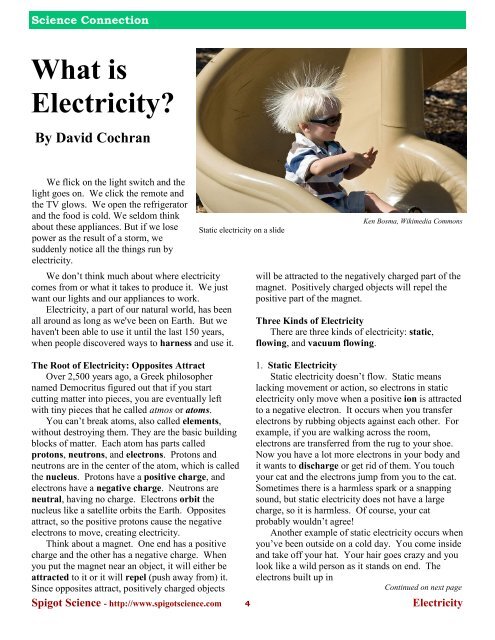Electricity - Spigot Science
Electricity - Spigot Science
Electricity - Spigot Science
Create successful ePaper yourself
Turn your PDF publications into a flip-book with our unique Google optimized e-Paper software.
<strong>Science</strong> ConnectionWhat is<strong>Electricity</strong>?By David CochranWe flick on the light switch and thelight goes on. We click the remote andthe TV glows. We open the refrigeratorand the food is cold. We seldom thinkabout these appliances. But if we losepower as the result of a storm, wesuddenly notice all the things run byelectricity.We don’t think much about where electricitycomes from or what it takes to produce it. We justwant our lights and our appliances to work.<strong>Electricity</strong>, a part of our natural world, has beenall around as long as we've been on Earth. But wehaven't been able to use it until the last 150 years,when people discovered ways to harness and use it.The Root of <strong>Electricity</strong>: Opposites AttractOver 2,500 years ago, a Greek philosophernamed Democritus figured out that if you startcutting matter into pieces, you are eventually leftwith tiny pieces that he called atmos or atoms.You can’t break atoms, also called elements,without destroying them. They are the basic buildingblocks of matter. Each atom has parts calledprotons, neutrons, and electrons. Protons andneutrons are in the center of the atom, which is calledthe nucleus. Protons have a positive charge, andelectrons have a negative charge. Neutrons areneutral, having no charge. Electrons orbit thenucleus like a satellite orbits the Earth. Oppositesattract, so the positive protons cause the negativeelectrons to move, creating electricity.Think about a magnet. One end has a positivecharge and the other has a negative charge. Whenyou put the magnet near an object, it will either beattracted to it or it will repel (push away from) it.Since opposites attract, positively charged objectsStatic electricity on a slideKen Bosma, Wikimedia Commonswill be attracted to the negatively charged part of themagnet. Positively charged objects will repel thepositive part of the magnet.Three Kinds of <strong>Electricity</strong>There are three kinds of electricity: static,flowing, and vacuum flowing.1. Static <strong>Electricity</strong>Static electricity doesn’t flow. Static meanslacking movement or action, so electrons in staticelectricity only move when a positive ion is attractedto a negative electron. It occurs when you transferelectrons by rubbing objects against each other. Forexample, if you are walking across the room,electrons are transferred from the rug to your shoe.Now you have a lot more electrons in your body andit wants to discharge or get rid of them. You touchyour cat and the electrons jump from you to the cat.Sometimes there is a harmless spark or a snappingsound, but static electricity does not have a largecharge, so it is harmless. Of course, your catprobably wouldn’t agree!Another example of static electricity occurs whenyou’ve been outside on a cold day. You come insideand take off your hat. Your hair goes crazy and youlook like a wild person as it stands on end. Theelectrons built up inContinued on next page<strong>Spigot</strong> <strong>Science</strong> - http://www.spigotscience.com 4 <strong>Electricity</strong>


